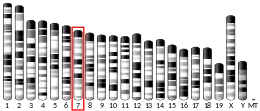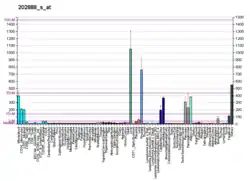Alanine aminopeptidase
Membrane alanyl aminopeptidase (EC 3.4.11.2) also known as alanyl aminopeptidase (AAP) or aminopeptidase N (AP-N) is an enzyme that in humans is encoded by the ANPEP gene.
Function
Aminopeptidase N is located in the small-intestinal and renal microvillar membrane, and also in other plasma membranes. In the small intestine aminopeptidase N plays a role in the final digestion of peptides generated from hydrolysis of proteins by gastric and pancreatic proteases. Its function in proximal tubular epithelial cells and other cell types is less clear. The large extracellular carboxyterminal domain contains a pentapeptide consensus sequence characteristic of members of the zinc-binding metalloproteinase superfamily. Sequence comparisons with known enzymes of this class showed that CD13 and aminopeptidase N are identical. The latter enzyme was thought to be involved in the metabolism of regulatory peptides by diverse cell types, including small intestinal and renal tubular epithelial cells, macrophages, granulocytes, and synaptic membranes from the CNS. Defects in this gene appear to be a cause of various types of leukemia or lymphoma.[5]
AAP is also used by some viruses as a receptor to which these viruses bind to and then enter cells. It is a receptor for human coronavirus 229E, feline coronavirus serotype II (FCoV-II), TGEV, PEDV[6] and canine coronavirus genotype II (CCoV-II).[7]
References
- GRCh38: Ensembl release 89: ENSG00000166825 - Ensembl, May 2017
- GRCm38: Ensembl release 89: ENSMUSG00000039062 - Ensembl, May 2017
- "Human PubMed Reference:". National Center for Biotechnology Information, U.S. National Library of Medicine.
- "Mouse PubMed Reference:". National Center for Biotechnology Information, U.S. National Library of Medicine.
- "Entrez Gene: ANPEP alanyl (membrane) aminopeptidase (aminopeptidase N, aminopeptidase M, microsomal aminopeptidase, CD13, p150)".
- Jaimes JA, et al. (2020). "A tale of two viruses: the distinct spike glycoproteins of feline coronaviruses". Viruses. 12 (1). doi:10.3390/v12010083. PMC 7019228. PMID 31936749.
- Licitra BN, et al. (2014). "Genotypic characterization of canine coronaviruses associated with fatal canine neonatal enteritis in the United States". Journal of Clinical Microbiology. 52 (12): 4230–4238. doi:10.1128/JCM.02158-14. PMC 4313292. PMID 25253797.
Further reading
- Yeager CL, Ashmun RA, Williams RK, Cardellichio CB, Shapiro LH, Look AT, Holmes KV (June 1992). "Human aminopeptidase N is a receptor for human coronavirus 229E". Nature. 357 (6377): 420–2. doi:10.1038/357420a0. PMID 1350662.
- Shapiro LH, Ashmun RA, Roberts WM, Look AT (June 1991). "Separate promoters control transcription of the human aminopeptidase N gene in myeloid and intestinal epithelial cells". The Journal of Biological Chemistry. 266 (18): 11999–2007. PMID 1675638.
- O'Connell PJ, Gerkis V, d'Apice AJ (March 1991). "Variable O-glycosylation of CD13 (aminopeptidase N)". The Journal of Biological Chemistry. 266 (7): 4593–7. PMID 1705556.
- Watt VM, Willard HF (October 1990). "The human aminopeptidase N gene: isolation, chromosome localization, and DNA polymorphism analysis". Human Genetics. 85 (6): 651–4. doi:10.1007/BF00193592. PMID 1977688.
- Look AT, Peiper SC, Rebentisch MB, Ashmun RA, Roussel MF, Lemons RS, Le Beau MM, Rubin CM, Sherr CJ (October 1986). "Molecular cloning, expression, and chromosomal localization of the gene encoding a human myeloid membrane antigen (gp150)". The Journal of Clinical Investigation. 78 (4): 914–21. doi:10.1172/JCI112680. PMC 423717. PMID 2428842.
- Look AT, Ashmun RA, Shapiro LH, Peiper SC (April 1989). "Human myeloid plasma membrane glycoprotein CD13 (gp150) is identical to aminopeptidase N". The Journal of Clinical Investigation. 83 (4): 1299–307. doi:10.1172/JCI114015. PMC 303821. PMID 2564851.
- Olsen J, Cowell GM, Kønigshøfer E, Danielsen EM, Møller J, Laustsen L, Hansen OC, Welinder KG, Engberg J, Hunziker W (October 1988). "Complete amino acid sequence of human intestinal aminopeptidase N as deduced from cloned cDNA". FEBS Letters. 238 (2): 307–14. doi:10.1016/0014-5793(88)80502-7. PMID 2901990.
- Kruse TA, Bolund L, Grzeschik KH, Ropers HH, Olsen J, Sjöström H, Norén O (November 1988). "Assignment of the human aminopeptidase N (peptidase E) gene to chromosome 15q13-qter". FEBS Letters. 239 (2): 305–8. doi:10.1016/0014-5793(88)80940-2. PMID 2903074.
- Tokioka-Terao M, Hiwada K, Kokubu T (1985). "Purification and characterization of aminopeptidase N from human plasma". Enzyme. 32 (2): 65–75. PMID 6149934.
- Watanabe Y, Iwaki-Egawa S, Mizukoshi H, Fujimoto Y (July 1995). "Identification of an alanine aminopeptidase in human maternal serum as a membrane-bound aminopeptidase N". Biological Chemistry Hoppe-Seyler. 376 (7): 397–400. doi:10.1515/bchm3.1995.376.7.397. PMID 7576235.
- Favaloro EJ, Browning T, Facey D (December 1993). "CD13 (GP150; aminopeptidase-N): predominant functional activity in blood is localized to plasma and is not cell-surface associated". Experimental Hematology. 21 (13): 1695–701. PMID 7902291.
- Núñez L, Amigo L, Rigotti A, Puglielli L, Mingrone G, Greco AV, Nervi F (August 1993). "Cholesterol crystallization-promoting activity of aminopeptidase-N isolated from the vesicular carrier of biliary lipids". FEBS Letters. 329 (1–2): 84–8. doi:10.1016/0014-5793(93)80199-5. PMID 8102610.
- Söderberg C, Giugni TD, Zaia JA, Larsson S, Wahlberg JM, Möller E (November 1993). "CD13 (human aminopeptidase N) mediates human cytomegalovirus infection". Journal of Virology. 67 (11): 6576–85. PMC 238095. PMID 8105105.
- Kolb AF, Maile J, Heister A, Siddell SG (October 1996). "Characterization of functional domains in the human coronavirus HCV 229E receptor". The Journal of General Virology. 77 (10): 2515–21. doi:10.1099/0022-1317-77-10-2515. PMID 8887485.
- Norén K, Hansen GH, Clausen H, Norén O, Sjöström H, Vogel LK (February 1997). "Defectively N-glycosylated and non-O-glycosylated aminopeptidase N (CD13) is normally expressed at the cell surface and has full enzymatic activity". Experimental Cell Research. 231 (1): 112–8. doi:10.1006/excr.1996.3455. PMID 9056417.
- Kolb AF, Hegyi A, Siddell SG (November 1997). "Identification of residues critical for the human coronavirus 229E receptor function of human aminopeptidase N". The Journal of General Virology. 78 (11): 2795–802. doi:10.1099/0022-1317-78-11-2795. PMID 9367365.
- Hegyi A, Kolb AF (June 1998). "Characterization of determinants involved in the feline infectious peritonitis virus receptor function of feline aminopeptidase N". The Journal of General Virology. 79 (6): 1387–91. doi:10.1099/0022-1317-79-6-1387. PMID 9634079.
- Dong X, An B, Salvucci Kierstead L, Storkus WJ, Amoscato AA, Salter RD (January 2000). "Modification of the amino terminus of a class II epitope confers resistance to degradation by CD13 on dendritic cells and enhances presentation to T cells". Journal of Immunology. 164 (1): 129–35. doi:10.4049/jimmunol.164.1.129. PMID 10605003.
- Pasqualini R, Koivunen E, Kain R, Lahdenranta J, Sakamoto M, Stryhn A, Ashmun RA, Shapiro LH, Arap W, Ruoslahti E (February 2000). "Aminopeptidase N is a receptor for tumor-homing peptides and a target for inhibiting angiogenesis". Cancer Research. 60 (3): 722–7. PMC 4469333. PMID 10676659.
- Renold A, Cescato R, Beuret N, Vogel LK, Wahlberg JM, Brown JL, Fiedler K, Spiess M (March 2000). "Basolateral sorting signals differ in their ability to redirect apical proteins to the basolateral cell surface". The Journal of Biological Chemistry. 275 (13): 9290–5. doi:10.1074/jbc.275.13.9290. PMID 10734069.
External links
- The MEROPS online database for peptidases and their inhibitors: M01.001
- CD13+Antigens at the US National Library of Medicine Medical Subject Headings (MeSH)
- Human ANPEP genome location and ANPEP gene details page in the UCSC Genome Browser.




